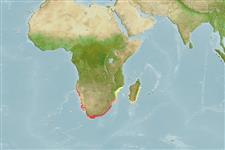Environment: milieu / climate zone / depth range / distribution range
Écologie
marin benthopélagique; profondeur 20 - 150 m (Ref. 27121). Subtropical; 17°S - 36°S
Southeast Atlantic: Namibia (Ref. 27121) and South Africa to Beira, Mozambique (Ref. 3198).
Length at first maturity / Taille / Poids / Âge
Maturity: Lm 20.4 range ? - 26 cm
Max length : 45.0 cm TL mâle / non sexé; (Ref. 3669); common length : 27.0 cm TL mâle / non sexé; (Ref. 3507)
Épines dorsales (Total): 12; Rayons mous dorsaux (Total): 10; Épines anales 3; Rayons mous anaux: 8. Lips furry.
Found in coastal waters, over soft bottoms (Ref. 27121). Forms large schools (Ref. 5213). Sold fresh.
Life cycle and mating behavior
Maturité | Reproduction | Frai | Œufs | Fécondité | Larves
Conflicting descriptions of the reproductive style of this species have been reported, e.g., Ref. 34231 describe this species as being a gonochorist (Ref. 28504). After clarificatory analyses on the protogynous characteristics (Ref. 7124) of this species, gonochorism is confirmed (Ref. 103751).
Bauchot, M.-L. and M.M. Smith, 1984. Sparidae. In W. Fischer and G. Bianchi (eds.) FAO species identification sheets for fishery purposes. Western Indian Ocean (Fishing Area 51). volume 4. [var. pag.] FAO, Rome. (Ref. 3507)
Statut dans la liste rouge de l'IUCN (Ref. 130435)
Menace pour l'homme
Harmless
Utilisations par l'homme
Pêcheries: commercial
Plus d'informations
RéférencesAquacultureProfil d'aquacultureSouchesGénétiqueElectrophoresesHéritabilitéPathologiesTraitementNutrientsMass conversion
CollaborateursImagesStamps, Coins Misc.SonsCiguateraVitesseType de nageSurface branchialeOtolithesCerveauxVision
Outils
Articles particuliers
Télécharger en XML
Sources Internet
Estimates based on models
Preferred temperature (Ref.
123201): 13.4 - 25.2, mean 18.5 °C (based on 33 cells).
Phylogenetic diversity index (Ref.
82804): PD
50 = 1.0000 [Uniqueness, from 0.5 = low to 2.0 = high].
Bayesian length-weight: a=0.01660 (0.00997 - 0.02764), b=3.05 (2.91 - 3.19), in cm total length, based on LWR estimates for this species & (Sub)family-body (Ref.
93245).
Niveau trophique (Ref.
69278): 3.6 ±0.46 se; based on food items.
Résilience (Ref.
120179): Faible, temps minimum de doublement de population : 4,5 à 14 années (K=0.13-0.19; tm=6-7; tmax=11).
Fishing Vulnerability (Ref.
59153): Moderate to high vulnerability (47 of 100).
Climate Vulnerability (Ref.
125649): Moderate to high vulnerability (53 of 100).
Nutrients (Ref.
124155): Calcium = 55.3 [30.5, 101.4] mg/100g; Iron = 0.825 [0.468, 1.410] mg/100g; Protein = 19 [18, 20] %; Omega3 = 0.385 [0.264, 0.575] g/100g; Selenium = 29.6 [14.6, 55.5] μg/100g; VitaminA = 20.1 [5.9, 63.5] μg/100g; Zinc = 0.805 [0.574, 1.140] mg/100g (wet weight);
